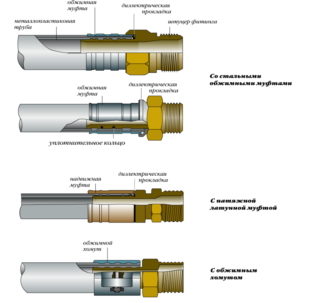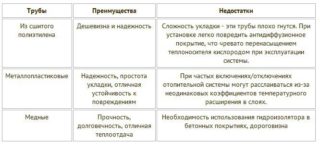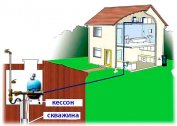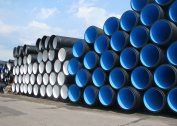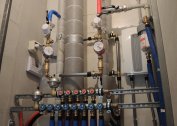Plastic pipes are widely used for heating and hot water systems. Due to its reliable technical characteristics, combining the strength of the metal and the elasticity of the polymer, the communication elements serve regularly up to 30 years or more. The main thing is to choose the right diameter of metal-plastic pipes for water supply / heating.
Design features of tubes made of metal
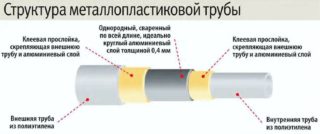 Structurally, the tube looks like this:
Structurally, the tube looks like this:
- inner polyethylene layer providing a supporting function;
- top layer of aluminum foil - stabilizes the product and prevents oxygen diffusion;
- the outer polyethylene layer having a light shade - performs a decorative and protective function.
Between each layer of the metal-plastic pipe a special glue is laid.
Specifications
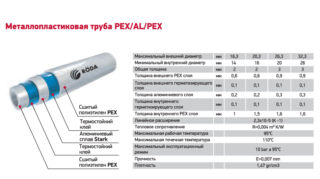 Plastic products differ in such technical characteristics:
Plastic products differ in such technical characteristics:
- low level of thermal conductivity - 1300 times lower than that of copper, and 175 times less than steel;
- wall thickness from 2 mm or more, depending on the size of the metal-plastic water pipes (section);
- good antistaticity - lack of conductivity of stray currents;
- mass per meter of product with a diameter of 16 mm. - 115 gr.;
- throughput - 0.113 l / meter for a product with a cross section of 16 mm;
- strength at transverse rupture - 2880 n;
- the roughness coefficient of the inner walls is 0.07;
- the rate of expansion of plastic - 0.26x10-4 per ºС;
- minimum permissible bending of the product - from 45 mm.
For all types of metal-plastic tubes, the adhesive strength of the aluminum layer is from 70 n / 10 mm2.
Types of metal-plastic pipes for water supply
All tubes made of metal-plastic are conventionally divided into two types according to the type of product composition:
- elements marked PEX (cross-linked polyethylene);
- PE-RT pipes (heat-resistant polymer).
In turn, all PEX products having crosslinked molecular chains are further classified as follows:
- Pex-a. They have a maximum firmware step of 85%. Extremely durable and flexible.
- Pex-b. The degree of firmware is 65%. The processing of the layers is carried out using silane. Pipes are less flexible, which means that there are restrictions on permissible bending.
- Pex-c. The main advantage of such a tube is its favorable cost. PEX-C products are ideal for straight sections without the need for material bending.
There are PEX-D tubes. Their production is reduced because the products do not withstand competition with more advanced models.
All tubes without exception are specially marked. She is prescribed in this order:
- manufacturer;
- certificate or GOST, according to which the products are manufactured;
- type of material and stitching method (PP-R, PE-R, PE-X);
- product diameter plus its wall thickness (cross-section is indicated in mm, in rare cases, in inches);
- nominal pressure in bar;
- type of transported medium (water pipes are not suitable for sending aggressive compounds over them);
- lot number and production date of the product.
All marking is applied to the tube in a continuous font.
How to choose
When buying products for water supply or heating, the master should pay attention to such parameters:
- the thickness of the reinforcing layer - the larger it is, the tougher and stronger the product;
- purpose of pipes - for water, heating, aggressive environments having a specific temperature during transportation;
- type of crosslinking - the higher it is, the more flexible the tube will be to bend;
- producer - the cost of production often depends on it.
It is advisable to take items in specialized stores in which the buyer is given a check. If necessary, it will be possible to return the goods or exchange it.
Assembly and connection
When installing a heating / water supply system, the master can join pipes in two ways:
- using press fittings;
- using screw compression fitting.
Work with the use of the press is performed as follows:
- cut the desired piece of tube with special scissors;
- using a calibrator, the inner chamfer is cut from the prepared element (one end of it);
- do the same from the outside of the pipe;
- the calibrator evens out possible wrinkled places in the lumen of the product;
- push the shank of the press fitting all the way;
- insert the sleeve into the press and bring its handles all the way.
This method of joining tubes from a metal polymer is considered the most reliable.
If the master uses a screw compression fitting, the joining of the two elements takes place in the following sequence:
- cut off the desired section of the product;
- remove the inner and outer chamfers;
- a crimp ring and a tightening nut are mounted on the prepared end;
- the end of the second pipe is driven into the connecting element;
- pull the crimping ring and the tightening nut to the fitting until it stops, so that it covers the ring; here it is important not to make critical efforts so as not to break the thread; the connection can be sealed with fum tape.
It is forbidden to wall sections of tubes connected with fittings into walls / floors. Only straightforward, inextricable sections of communication can be removed into cement.
Advantages and disadvantages
Important positive aspects of metal polymer products are:
- perfect smoothness of the inner walls, which prevents siltation of the system;
- durability - the service life of a metal-polymer multilayer pipe for hot water supply is about 50 years;
- inertness to corrosion and aggressive environments;
- good ductility;
- light weight, which facilitates the transportation of products and their installation;
- simple installation of cold or hot water supply systems that do not require complex tools;
- soundproof characteristics - water transportation through such systems is almost inaudible;
- aesthetics.
With their positive characteristics, pipes made of metal-plastic are not without drawbacks. The main disadvantage is the different expansion coefficients of the polymer and the metal layer at temperature extremes. As a result, over time, the joints may weaken, leading to leaks.
Tubes are afraid of the sun, so they are used for laying internal communications in an apartment, bath, country house. Sunlight provokes heating and further expansion of the tube. At the same time, cold water reduces the polymer. Temperature differences are undesirable for such a material.
The price of metal pipes
The cost of products varies depending on the manufacturer and the diameter. Average prices for pipes for water pipes made of metal-plastic in Moscow:
| Manufacturer | Country | Price m / linear ($) |
| Valtec | Russia, Italy | from 1,5 |
| Oventrop | Germany | from 1,2 |
| Henko | Belgium | from 0.8 |
| Nanoplast | Russia | from 0.7 |
| Comap | France | from 1,6 |
Prices are for pipes with a diameter of 16 mm. The larger the cross section of the product, the higher its cost per linear meter. In addition, prices may vary slightly depending on the region of sales.

